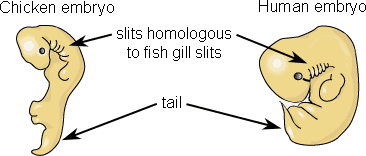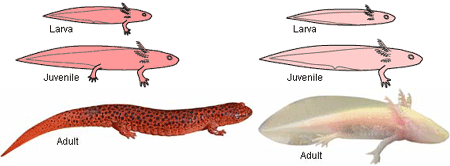Learning about phylogeny from ontogeny
By studying ontogeny (the development of embryos), scientists can learn about the evolutionary history of organisms. Ancestral characters are often, but not always, preserved in an organism’s development. For example, both chick and human embryos go through a stage where they have slits and arches in their necks that are identical to the gill slits and gill arches of fish. This observation supports the idea that chicks and humans share a common ancestor with fish. Thus, developmental characters, along with other lines of evidence, can be used for constructing phylogenies.

Not recapitulation
In the late 1800s some scientists felt that ontogeny not only could reveal something about evolutionary history, but that it also preserved a step-by-step record of that history. These scientists claimed that ontogeny recapitulates phylogeny (ORP). This phrase suggests that an organism’s development will take it through each of the adult stages of its evolutionary history, or its phylogeny. At the time, some scientists thought that evolution worked by adding new stages on to the end of an organism’s development. Thus its development would reiterate its evolutionary history — ontogeny recapitulating phylogeny.
This idea is an extreme one. If it were strictly true, it would predict, for example, that in the course of a chick’s development, it would go through the following stages: a single celled organism, a multi-celled invertebrate ancestor, a fish, a lizard-like reptile, an ancestral bird, and then finally, a baby chick.

This is clearly not the case — a fact recognized by many scientists even when the idea of ontogeny recapitulating phylogeny was introduced. If you observe a chick’s development, you will find that the chick embryo may resemble the embryos of reptiles and fish at points in its development, but it doesn’t recapitulate the forms of its adult ancestors.

Even on a smaller scale, ORP is often untrue. For example, the axolotl evolved from a salamander ancestor that had internal gills in the adult stage. However, the axolotl never develops through a stage with internal gills; its gills remain external in flagrant violation of ORP.

If ORP were completely true, it would certainly make constructing phylogenies a lot easier. We could study an organism’s development and read its history directly. Unfortunately, phylogeneticists are out of luck here.
Read more about the history of ideas on ontogeny and phylogeny.
Learn more about evolution and development in context: Why the eye?, a case study.
Teach your students about development:
Find additional lessons, activities, videos, and articles that focus on development.
